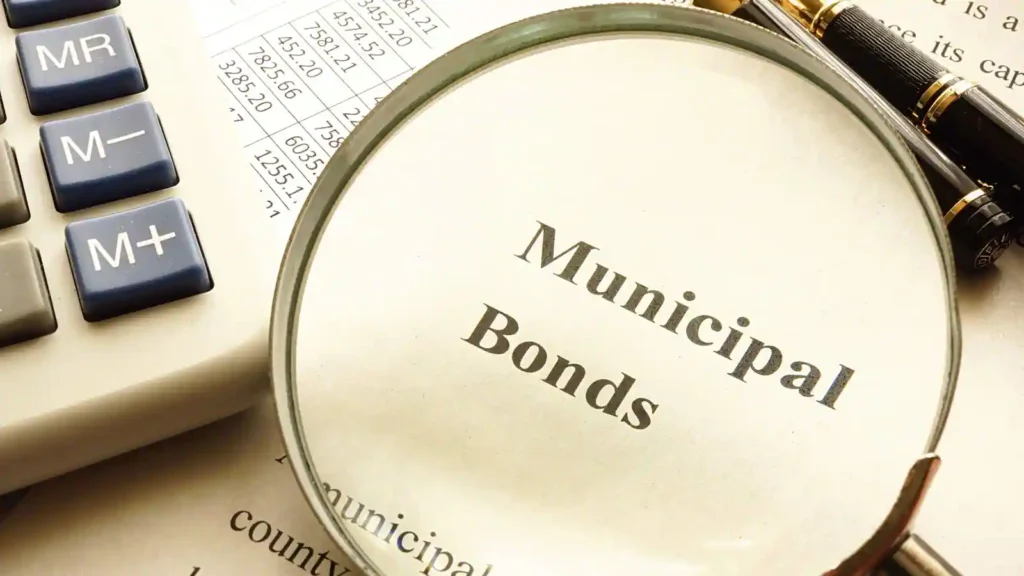

A municipal bond is a debt obligation issued by a nonprofit, a business in the private sector, or another public entity that will use the funds for public projects like building schools, hospitals, and roads.
Municipal bonds have lower coupon (interest) rates than taxable bonds but can produce a tax-free income for qualified people. What else do you need to know about municipal bonds in order not to be afraid to invest in them?

What are municipal bonds?
Municipal bonds are a type of investment that allows investors to participate in the growth and profitability of municipal entities. They are typically issued by municipalities, counties, or states and can be purchased through mutual fund companies or other institutional investors.
Inflation Protection and coupon interest payments generate the bulk of municipal bond returns. If the issuer cannot make required debt service payments, the bond may be sold at a discount, and the investor may receive back less than their original investment. Municipal bonds typically have maturities ranging from 1 to 30 years, with currently issued securities having terms up to 20 years due to rising demand for longer-term investments.
Municipal bonds are considered safe investments with a lower risk profile than other securities. The average rating for municipal bonds is AA+, compared to the A+ grade assigned to more speculative stocks. Municipal bonds are resilient during economic uncertainty, providing stability and safety during challenging market conditions.
How do municipal bonds work?
Municipal bond returns are generated primarily through inflation protection and coupon interest payments. If the issuer cannot make required debt service payments, the bond may be sold at a discount, and the investor may receive back less than their original investment.
Municipal bonds vs. Corporate bonds
There are several distinctions between municipal bonds and corporate bonds:
- Municipal bonds are typically considered more stable investments and can maintain their value in times of market turmoil, while corporate bonds may experience greater price volatility.
- Corporate bonds have maturities of up to 30 years; municipal bonds typically have maturities ranging from 1 to 20 years. It is partly because long-term debt obligations can be riskier for investors who seek more security and stability when investing.
- Municipal bonds provide a higher yield than corporate ones. It is partly because municipal bond yields are typically fixed for an extended period (generally 10-30 years). In contrast, corporate bond yields may fluctuate depending on market conditions.
- While municipal bonds will typically offer more excellent stability and safety compared to corporate bonds, they are not immune from default. You may experience losses in the event of insolvency or financial impairment of the company.
Note! Municipal bonds offer investors a stable, income-producing investment with minimal risk.

Types of municipal bonds
There are a few different types of municipal bonds:
- General obligation bonds are the most common type of municipal bond and offer investors the highest level of security compared to other types. These bonds typically have maturities ranging from 1-10 years and invest in projects that benefit the general public (e.g., schools, highways).
- Revenue anticipation notes (RANs) are municipals that derive revenue from an anticipated increase in tax receipts rather than through traditional sources such as property taxes or user fees. While they carry the same level of security as general obligation bonds, RANs typically have shorter maturities (ranging from 1-3 years) and are geared towards investors looking for a higher yield.
- Tax-funded debt – bonds offer investors unique benefits compared to other types of municipal bonds, including the potential for tax-exempt interest payments. In addition, while they carry the same level of security as general obligation bonds, bonds are intended specifically for investors who want to refund social welfare programs or infrastructure projects.
- Conservation financing – these municipalities invest in environmentally friendly development projects that reduce energy consumption, waste production, and overall environmental impact.
- Tax increment financing (TIFs) are municipals that use borrowed funds to invest in property tax-increment generating projects within their municipality. It can include anything from the redevelopment of an underutilized city section to the construction of new public facilities.
Credit risk levels of municipal bonds
While all municipal bonds carry the same level of risk (i.e., the issuer could default on the debt), there are different credit risk levels that investors may want to consider when evaluating a particular bond. Here are four of the most common types of the Credit risk level:
- Low credit quality. These municipals have lower ratings from financial institutions, making them more susceptible to default and other risks associated with investing in low-quality debt instruments.
- High credit quality. They have higher ratings from financial institutions, meaning they’re less likely to default on their debt.
- BBB-rated bonds. These municipals have a rating of “BBB” from rating services, which means they’re generally considered to be in good financial condition and are likely to pay the interest and principal on their debt obligations.
- A+ rated bonds. They have an A+ rating from rating agencies and are considered one of the highest quality municipal securities.
Tax bracket changes
Municipal bonds typically offer investors different tax brackets, which can impact their overall return. For example, a bond issued in the 20% federal marginal income tax bracket will have a higher initial yield than one published in the 10% state or local marginal income tax bracket. It is because taxes are paid on municipal bonds.
When a bond is redeemed, the interest and principal that were originally paid out are taxes refunded to the investor. It can result in significant tax savings for investors who hold taxable municipal bonds – even if they don’t live in a municipality where those bonds are issued.
Call risk of municipal bonds
Municipal bonds are often called “callable” securities, which means that the bond issuer can demand that investors return their money within a certain timeframe (usually within six months). If market conditions change and it becomes difficult for the municipality to meet its debt obligations, call risk could lead to significant losses for bondholders.
Market risk of municipal bonds
A municipal bond is an investment typically subject to the risk of default – meaning that the municipality may not be able to meet its debt obligations. If this happens, investors could lose a great deal of money. As a result, municipal bonds are considered a “safe” investment option, although there is still some risk involved. For this reason, it’s important to do your research and understand the risks involved before investing in municipal bonds.
Buying strategies of municipal bonds
Regarding municipal bonds, investors can use a few different strategies.
One strategy is buying a bond ladder is an investment portfolio made up of several different types of municipal bonds. By doing this, you can benefit from the positive returns that every kind of bond offers while limiting your overall risk.
Another strategy is to buy individual bonds, which allows you to invest in smaller issues without exposure to market fluctuations. It can be effective if you have specific criteria that you need to be fulfilled (like wanting relatively low-risk investments ) or if you want to invest in a particular municipality.
Investors should always research before investing in municipal bonds; market conditions can change rapidly, and there’s always the risk of losing money if the issuer fails to meet its obligations.
Evaluating stability vs. Fit
One of the key factors investors should consider when evaluating municipal bonds is their stability, that is, the likelihood that the issuer will be able to meet its obligations.
Stable municipalities tend to have lower default rates, so they’re generally a good option for long-term investments. However, there are also some fit issues that investors need to consider, like how closely related (and financially sound) the municipality is to your area.
For example, if you live in a municipality with serious financial problems, buying its bonds may not be wise. Tax benefits associated with municipal bonds duration.
Municipal bonds offer several tax benefits, such as deducting interest payments on them from your taxes. In addition, it can provide significant savings over time and can be especially beneficial if you’re in a high-income bracket.
There are many different types of municipal bonds available, so investors should research to find the ones that fit their specific needs and objectives.








